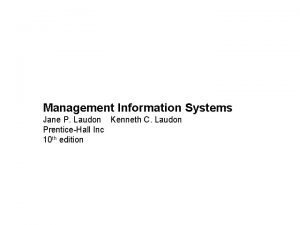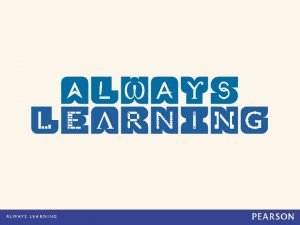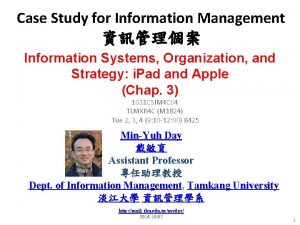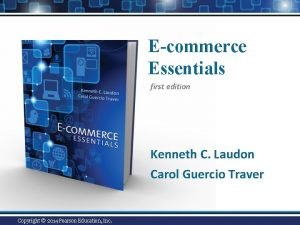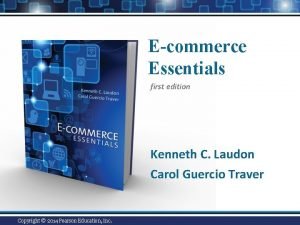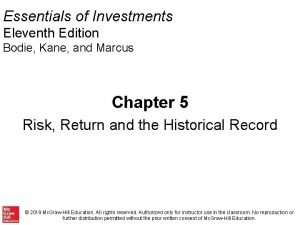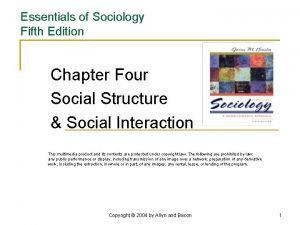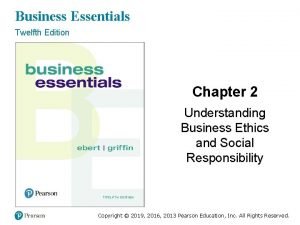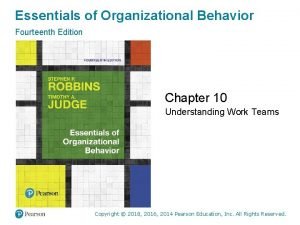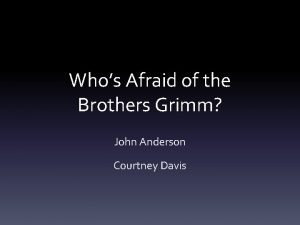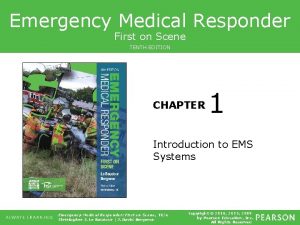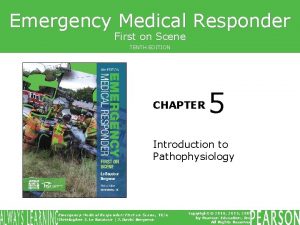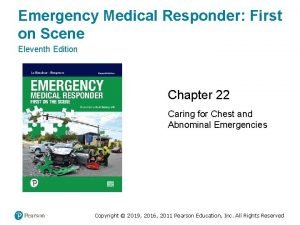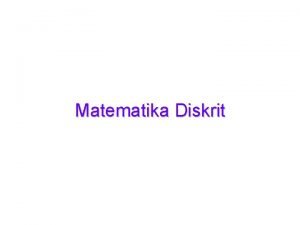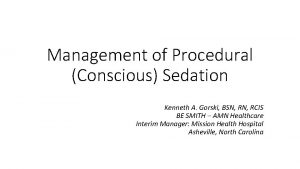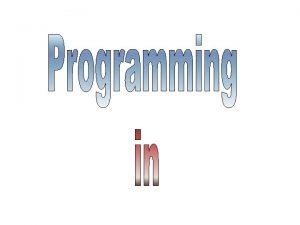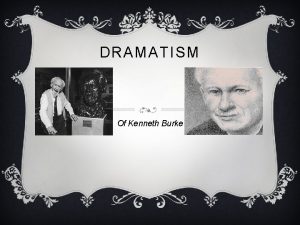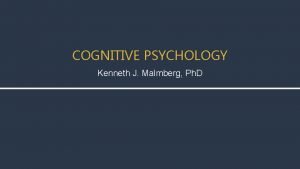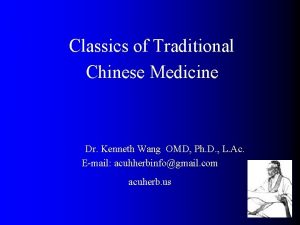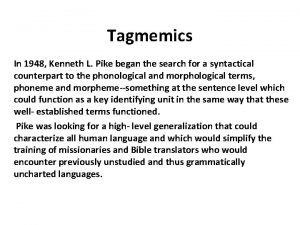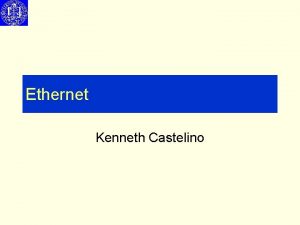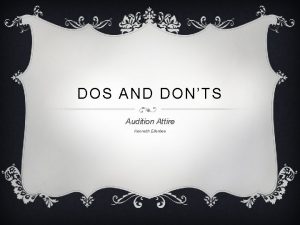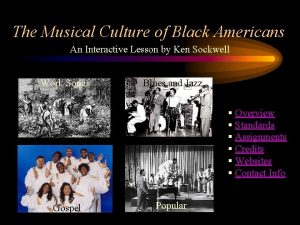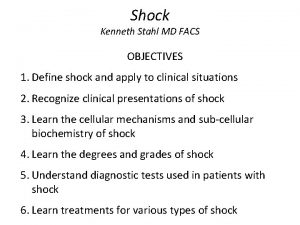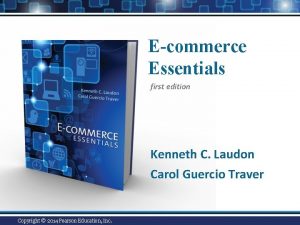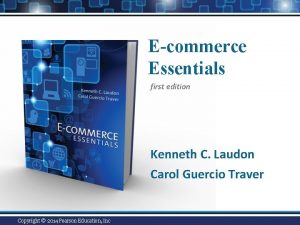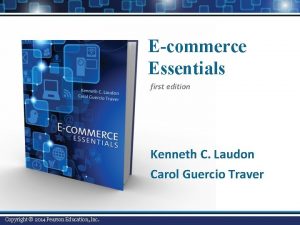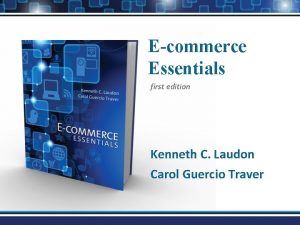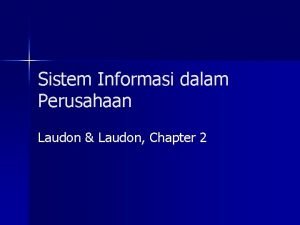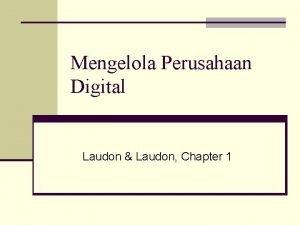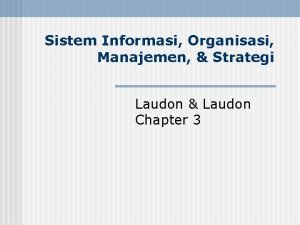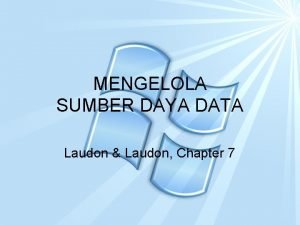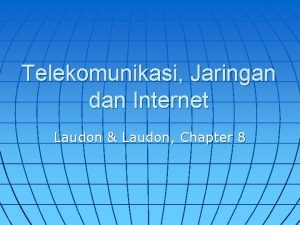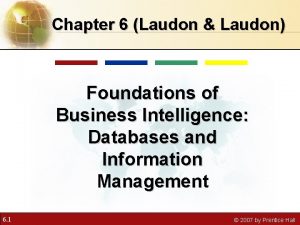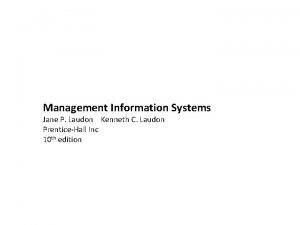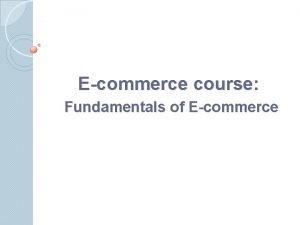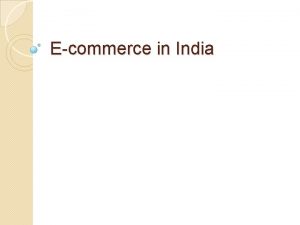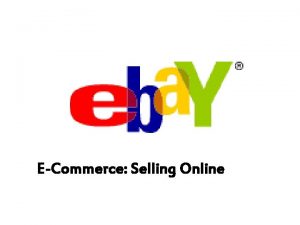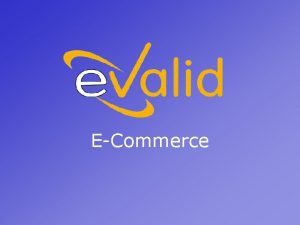Ecommerce Essentials first edition Kenneth C Laudon Carol










































- Slides: 42

E-commerce Essentials first edition Kenneth C. Laudon Carol Guercio Traver Copyright © 2014 Pearson Education, Inc.

Chapter 6 E-commerce Marketing Concepts: Social, Mobile, Local Copyright © 2014 Pearson Education, Inc.

Class Discussion Facebook: Does Social Marketing Work? n Have you ever made a purchase based on something you have read or seen on Facebook? What was the product and what made you interested? n What obstacles does Facebook face in monetizing itself as a marketing and advertising platform? n Are there other ways for Facebook to make a profit from marketers and advertisers? Copyright © 2014 Pearson Education, Inc. Slide 6 -3

Consumers Online: The Internet Audience and Consumer Behavior n Around 75% (89 million) of U. S. households have Internet access in 2012 n Growth rate has slowed n Intensity and scope of use both increasing n Some demographic groups have much higher percentages of online usage than others v Gender, age, ethnicity, community type, income, education Copyright © 2014 Pearson Education, Inc. Slide 6 -4

Consumers Online (cont. ) n Broadband vs. dial-up audiences, new mobile audience n Media choices v Traditional media competes with Internet for attention v Television viewing has increased with Internet usage Copyright © 2014 Pearson Education, Inc. Slide 6 -5

The Online Purchasing Decision n Stages in consumer decision process v Awareness of need v Search for more information v Evaluation of alternatives v Actual purchase decision v Post-purchase contact with firm n Factors that most influence purchasing decision v Price, free shipping, trusted seller status Copyright © 2014 Pearson Education, Inc. Slide 6 -6

The Consumer Decision Process and Supporting Communications Figure 6. 1, Page 214 Copyright © 2014 Pearson Education, Inc. Slide 6 -7

The Online Purchasing Decision (cont. ) n Decision process similar for online and offline behavior n General online behavior model v Consumer skills v Product characteristics v Attitudes toward online purchasing v Perceptions about control over Web environment v Web site features: latency, navigability, security n Clickstream behavior Copyright © 2014 Pearson Education, Inc. Slide 6 -8

A Model of Online Consumer Behavior Figure 6. 2, Page 215 Copyright © 2014 Pearson Education, Inc. Slide 6 -9

Shoppers: Browsers and Buyers n Shoppers: 88% of Internet users 72% buyers v 16% browsers (purchase offline) v One-third of offline retail purchases influenced by online activities n Online traffic also influenced by offline brands and shopping n E-commerce and traditional commerce are coupled: Part of a continuum of consuming behavior n Copyright © 2014 Pearson Education, Inc. Slide 6 -10

What Consumers Shop for and Buy Online n Big ticket items v Travel, computer hardware, electronics v Consumers now more confident in purchasing costlier items n Small ticket items ($100 or less) v Apparel, books, office supplies, software, etc. Copyright © 2014 Pearson Education, Inc. Slide 6 -11

How Shoppers Find Vendors Online n How shoppers find online vendors v Search engines— 59% v Marketplaces (Amazon, e. Bay)— 28% v Direct to retail sites— 10% v Other methods— 3% n Online shoppers are highly intentional Copyright © 2014 Pearson Education, Inc. Slide 6 -12

Why More People Don’t Shop Online n Largest factor: trust v Want to see and touch before buying v Concerns about financial information v Delivery costs too high v Concerns about returning items Copyright © 2014 Pearson Education, Inc. Slide 6 -13

Digital Commerce Marketing and Advertising Strategies and Tools n Internet marketing (vs. traditional) v More personalized v More participatory v More peer-to-peer v More communal n The most effective Internet marketing has all four features Copyright © 2014 Pearson Education, Inc. Slide 6 -14

Establishing the Customer Relationship n Web site functions to: v Establish brand identity and customer expectations n Differentiating product v Inform and educate customer v Shape customer experience v Anchor the brand online n Central point for all marketing messages Copyright © 2014 Pearson Education, Inc. Slide 6 -15

Online Marketing and Advertising Tools n Basic marketing and advertising tools: v Search engine marketing v Display ad marketing v E-mail and permission marketing v Affiliate marketing v Lead generation marketing v Sponsorship marketing Copyright © 2014 Pearson Education, Inc. Slide 6 -16

Search Engine Marketing and Advertising n $17. 6 billion spent in 2012 n Types: v Keyword paid inclusion v Advertising keywords v Network keyword advertising or context advertising n Nearly ideal targeted marketing Copyright © 2014 Pearson Education, Inc. Slide 6 -17

Search Engine Marketing and Advertising (cont. ) n Social search v Reviews friends recommendations, searches, Likes, and Web site visits n Search engine issues v Paid inclusion and placement practices v Link farms v Content farms v Click fraud Copyright © 2014 Pearson Education, Inc. Slide 6 -18

Display Ad Marketing n Banner ads v May include animation v Link to advertiser’s Web site v Can track user n Rich media ads v More effective than banner ads v Use animation, sound, and interactivity n Video ads v In-page commercials before or after content Copyright © 2014 Pearson Education, Inc. Slide 6 -19

Display Ad Marketing (cont. ) n Advertising networks v Sell marketing and advertising opportunities n Ad exchanges v Establish a real-time bidding process where marketers can bid on ad slots Copyright © 2014 Pearson Education, Inc. Slide 6 -20

E-mail Marketing n Direct e-mail marketing v Primary cost is purchasing addresses n Spam: Unsolicited commercial e-mail v Approximately 72% of all e-mail v Efforts to control spam: n Technology (filtering software) n Government regulation (CAN-SPAM and state laws) Copyright © 2014 Pearson Education, Inc. Slide 6 -21

Affiliate Marketing n Firms pay commissions to other Web sites for sending customers to theirs v Visitors to affiliate site click on ads v Advertisers pay fee to site Copyright © 2014 Pearson Education, Inc. Slide 6 -22

Lead Generation Marketing n Uses multiple e-commerce presences to generate leads v Help firms build Web sites, launch e-mail campaigns v $1. 7 billion spent in 2012 Copyright © 2014 Pearson Education, Inc. Slide 6 -23

Sponsorship Marketing n Sponsorships v Paid effort to tie advertiser’s name to particular information, event, and venue in a way that reinforces brand in positive yet not overtly commercial manner Copyright © 2014 Pearson Education, Inc. Slide 6 -24

Social Marketing and Advertising n Fastest growing type of online marketing and advertising n Long-term prospects unknown n Four features driving growth v Social sign-on v Collaborative shopping v Network notification v Social search (recommendation) Copyright © 2014 Pearson Education, Inc. Slide 6 -25

Social Marketing and Advertising (cont. ) n Facebook marketing products v Facebook pages v Like button v Display ads n Twitter marketing products v Promoted Tweets v Promoted Trends v Promoted Accounts Copyright © 2014 Pearson Education, Inc. Slide 6 -26

Social Marketing and Advertising (cont. ) n Blog advertising v 72 million read blogs v Blog readers are ideal demographic n Game advertising v Both branding and driving customers to purchases in retail stores and restaurants, etc. v Growing at nearly 50% n Viral marketing v Customers pass along marketing message via e-mail, social networks, blogs, video and game sites Copyright © 2014 Pearson Education, Inc. Slide 6 -27

Mobile Marketing n 7% of online marketing, growing rapidly n Formats include: v Search v Display ads v Video v E-mail v Text messaging v QR codes, couponing v Games Copyright © 2014 Pearson Education, Inc. Slide 6 -28

Insight on Business: Class Discussion Mobile Marketing: Land Rover Seeks Engagement on the Small Screen n Why do mobile devices represent such a promising opportunity for marketers? n Have you ever responded to mobile marketing messages? n What are some of the new types of marketing that mobile devices have spawned? n What the disadvantages of social network marketing? Copyright © 2014 Pearson Education, Inc. Slide 6 -29

App Marketing n Revenue sources v Pay-per-app v In-app purchase v Subscriptions v Advertising n Most popular types of apps v Social network, banking, search, news n Retailer’s apps v Browsing and purchasing Copyright © 2014 Pearson Education, Inc. Slide 6 -30

Local Marketing n Marketing geared to user’s geographic location n Local searches v 20% of all searches v 40% of mobile searches n Most common local marketing tools v Geotargeting with Google Maps v Display ads in hyperlocal publications Copyright © 2014 Pearson Education, Inc. Slide 6 -31

Multi-Channel Marketing n Average American spends 24% of media time on Internet, rest on other channels v Television, radio, newspapers, and magazines n Consumers also multitask, using several media n Internet campaigns strengthened by using other channels Copyright © 2014 Pearson Education, Inc. Slide 6 -32

Multi-Channel Marketing (cont. ) n One-to-one marketing (personalization) v Specific marketing messages to individuals n Interest-based advertising v Uses online and offline behavior of users to adjust messages n Retargeting ads v Shows same/similar ads to individuals across multiple sites Copyright © 2014 Pearson Education, Inc. Slide 6 -33

Multi-Channel Marketing (cont. ) n Customization and customer co- production v Changing products according to user preferences v Co-production—users help create product n Dynamic pricing and flash marketing v Merchants can change prices on the fly depending on demand Copyright © 2014 Pearson Education, Inc. Slide 6 -34

Long-Tail Marketing n Internet allows for sales of obscure products with little demand n Substantial revenue because v Near zero inventory costs v Little marketing costs v Search and recommendation engines Copyright © 2014 Pearson Education, Inc. Slide 6 -35

Insight on Technology: Class Discussion The Long Tail: Big Hits and Big Misses n What are “recommender systems”? Give an example you have used. n What is the “Long Tail” and how do recommender systems support sales of items in the Long Tail? n How can human editors, including consumers, make recommender systems more helpful? Copyright © 2014 Pearson Education, Inc. Slide 6 -36

Online Marketing Metrics: Lexicon n Audience size or market share v Impressions v Click-through rate (CTR) v View-through rate (VTR) v Hits v Page views v Stickiness (duration) v Unique visitors v Loyalty v Reach v Recency Copyright © 2014 Pearson Education, Inc. n Conversion to customer v Acquisition rate v Conversion rate v Browse-to-buy-ratio v View-to-cart ratio v Cart conversion rate v Checkout conversion rate v Abandonment rate v Retention rate v Attrition rate Slide 6 -37

Online Marketing Metrics (cont. ) n Social marketing n E-mail metrics v Gross rating points v Open rate v Applause ratio v Delivery rate v Conversation ratio v Click-through rate v Amplification v Sentiment ratio v Duration of engagement Copyright © 2014 Pearson Education, Inc. (e-mail) v Bounce-back rate v Unsubscribe rate v Conversion rate (e-mail) Slide 6 -38

How Well Does Online Advertising Work? n Use ROI to measure ad campaign n Highest click-through rates: Search engine ads, permission e-mail campaigns n Rich media, video interaction rates high n Online channels compare favorably with traditional n Most powerful marketing campaigns use multiple channels, including online, catalog, TV, radio, newspapers, stores Copyright © 2014 Pearson Education, Inc. Slide 6 -39

Comparative Returns on Investment Figure 6. 9, Page 249 Copyright © 2014 Pearson Education, Inc. SOURCES: Industry sources; authors’ estimates Slide 6 -40

The Costs of Online Advertising n Pricing models v v v n Online revenues only v n Sales can be directly correlated Both online/offline revenues v n Cost per thousand (CPM) Cost per click (CPC) Cost per action (CPA) Offline purchases cannot always be directly related to online campaign In general, online marketing more expensive on CPM basis, but more effective Copyright © 2014 Pearson Education, Inc. Slide 6 -41

Copyright © 2013 Pearson Education, Inc. Slide 6 -42
 Kenneth c. laudon jane p. laudon
Kenneth c. laudon jane p. laudon Laudon laudon schoder
Laudon laudon schoder Laudon and laudon 2012
Laudon and laudon 2012 Management information system case study
Management information system case study E-commerce presence map
E-commerce presence map Kenneth c. laudon
Kenneth c. laudon Ken ott ecommerce
Ken ott ecommerce Network security essentials 5th edition
Network security essentials 5th edition Business essentials 12th edition
Business essentials 12th edition Essentials of investments 11th edition
Essentials of investments 11th edition Business essentials 12th edition
Business essentials 12th edition Essentials of sociology 5th edition
Essentials of sociology 5th edition Firefighter essentials 7th edition
Firefighter essentials 7th edition Business essentials 12th edition
Business essentials 12th edition Essentials of mis, 13th edition
Essentials of mis, 13th edition Types of group
Types of group Fire fighting methods
Fire fighting methods Cryptographic systems are generically classified by
Cryptographic systems are generically classified by Nonintervention perspective of criminal justice
Nonintervention perspective of criminal justice Using mis (10th edition) 10th edition
Using mis (10th edition) 10th edition Report
Report Kinder- und hausmärchen first edition
Kinder- und hausmärchen first edition Emergency medical responder first on scene 10th edition
Emergency medical responder first on scene 10th edition Emergency medical responder first on scene 10th edition
Emergency medical responder first on scene 10th edition Emergency medical responder first on scene 11th edition
Emergency medical responder first on scene 11th edition Kenneth rosen discrete mathematics solutions
Kenneth rosen discrete mathematics solutions Dr kenneth gorski
Dr kenneth gorski Kenneth nelson sofi
Kenneth nelson sofi Kenneth lane thompson
Kenneth lane thompson Einar bergsholm
Einar bergsholm Atty. agustin patricio
Atty. agustin patricio Dramatism of kenneth burke
Dramatism of kenneth burke Kenneth malmberg
Kenneth malmberg Dr kenneth wang
Dr kenneth wang Kenneth røn christiansen
Kenneth røn christiansen Tagmemic model ni kenneth pike
Tagmemic model ni kenneth pike Kenneth castelino
Kenneth castelino Sangrado rojo rutilante
Sangrado rojo rutilante Kenneth ellerbee
Kenneth ellerbee Kenneth l. tyler
Kenneth l. tyler Ken sockwell apple valley
Ken sockwell apple valley Class of shock
Class of shock Kenneth lanzetta
Kenneth lanzetta
